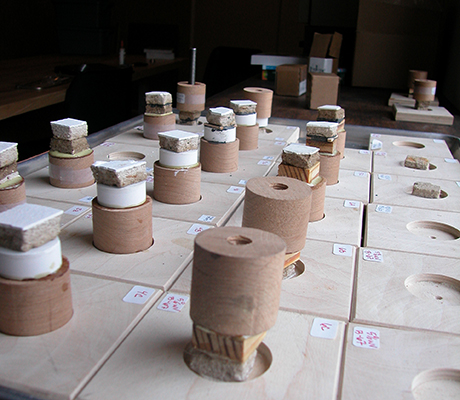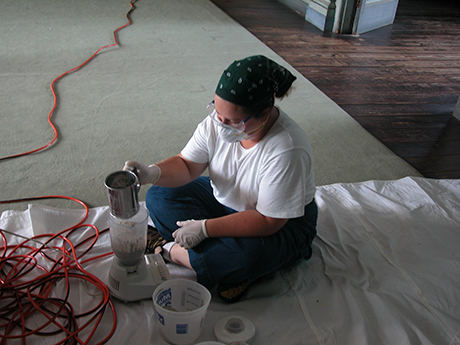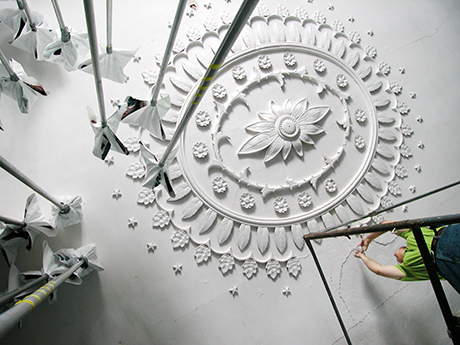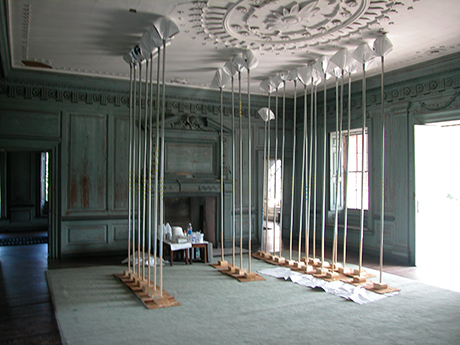|
A treatment testing program was developed to identify and select the most appropriate
formulations for reattaching the ceiling.
Morgan Phillip’s seminal article on the use of
acrylic emulsions for flexible and non-flexible reattachment of plaster
to its substrate (1980) was critical to the success of this project.
His mixes
used variations of the same
basic six ingredients including two acrylic emulsions as binders: Rhoplex MC-76 and Rhoplex LC-76.
Rhoplex
MC-76 is the stronger emulsion originally designed as a masonry bonding
agent
while Rhoplex 1950, the accepted replacement for LC-76, is the more
flexible
component originally designed as a binder for elastomeric sealants. In
the case
of all the flexible formulas, the mixtures were based on 3 parts
Rhoplex MC-76
to 1 part Rhoplex 1950 while the non-flexible used only Rhoplex MC-76.
Additionally
a thickener Acrysol ASE-60 was used to control viscosity and flow.
The
unfilled formulations using only the emulsions and thickener were intended for very small gapping.
Filled formulations were also designed to provide for more
significant gaps. For the filled formulations a mix of equal parts
lime, glass microspheres, and fluid petroleum coke were independently
incorporated together.
For these filled formulations where the Acrysol thickener was included,
all
mixtures were first thickened with 20% by volume of the emulsion
formulation prior to
the addition of the premixed dry filler
ingredients.
|
|
| All
testing was carried out at the Mechanical Testing Center of the University of
Pennsylvania under the guidance of the facility director Dr. Alex Radin. Tests
were run on the Instron testing machine model 4206, an electro-mechanical
system which uses a special digital data acquisition system called “Measure”
developed by National Instruments. The data collection system was a Microsoft
Excel add-in allowing for the collection of 2 independent channels of data to
be recorded in a spreadsheet. Channel 1 recorded the displacement of the
machine while channel 2 recorded the applied load. The software recorded 10
scans per second allowing for easy extrapolation for time in minutes. The test
carried out on the samples was a standard tensile strength test which involved
increasing the load applied to the sample by increasing displacement. All
samples were run at the same speed of 0.03 inches per minute until the sample
either failed completely in the case of the rigid samples or peak load had been
surpassed in the case of the flexible samples. |
|
|
The principle phase of treatment involved injection of the acrylic emulsion adhesive to
reattach areas of the ceiling which had been identified as detached but
which were still in place. Once areas had been identified for injection, holes
were drilled at an interval of approximately ½ inch using a 3/32-inch drill
bit. For each crack drilling was begun in the center of designated lengths
instead of at the ends. The purpose for this was to ensure that only damaged
areas were being drilled. As each consecutive hole was drilled in a given
direction along a crack, the amount of space within the gap between the plaster
and the lathing was monitored using a simple technique of intuitive sensing, when drilling through the plaster resistance
was noted. Once the bit exited the top side of the plaster and entered the
void, it would travel with no resistance until it came in contact with the
lathing and previous plaster repair above. As the drilling progressed along the length
of the crack' the distance the drill would travel unhindered in this gap would
change, reflecting the size of the void between the finished plaster surface
and the lathing. This gapping would continue to shrink until it would disappear
completely. At the point where this gapping ended, the drilling was
stopped and then reinitiated from the first
hole drilled traveling in the opposite direction along the crack.
|
|
|
|
 |
| All formulations were first tested for bonding
strength and flexibility in order to identify the best adhesive for the reattachment. |
|
 |
| High speed mixing ensured good dispersion of the formulation. |
|

|
| Using veterinary syringes, the acrylic emulsion was injected into small holes drilled along the pathway of
the cracks. After the emulsion was injected onto the voids, light
pressure was applied to the ceiling surface using custom designed padded extension
poles. |
|  |
| At
the end of each day, treated sections of the ceiling which had
been treated, were left with light pressure over night. |
|
|
|





